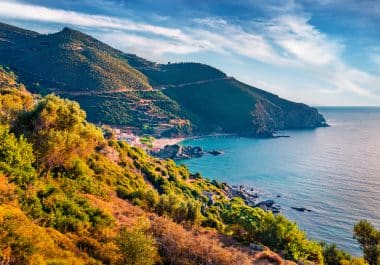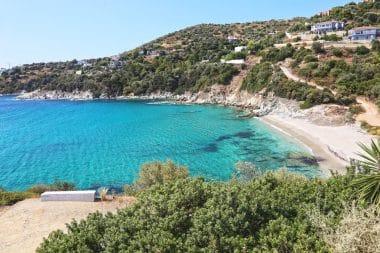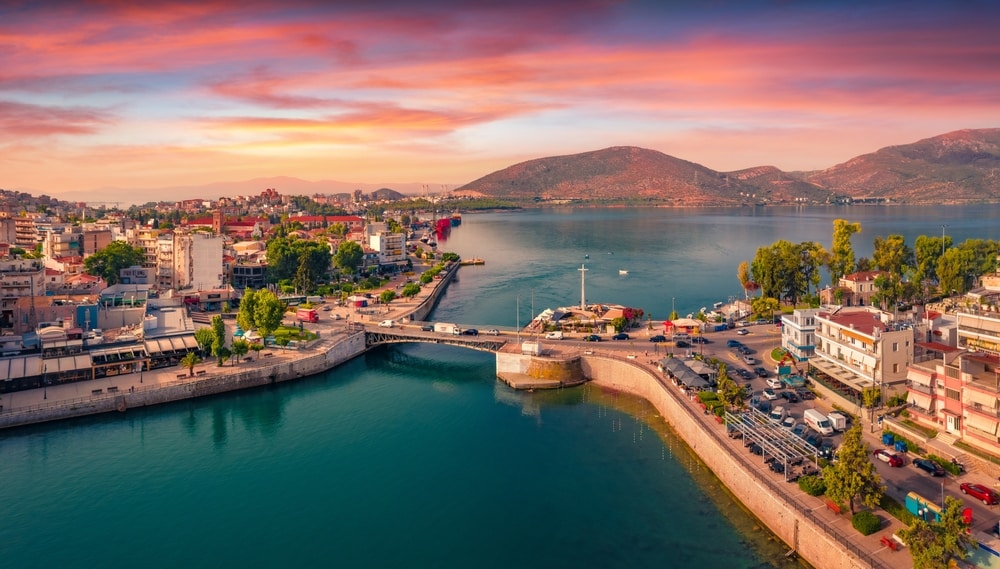When it comes to the largest islands in Greece, the popular travel destination of Crete is directly followed by the fascinating island world of Euboea. The much quieter island stands for natural relaxation on the Greek Aegean. From the big city of Chalkida with all its cultural richness to the mountains of Dirfys and Kymi to the dream beaches on the coast – natural Evia presents itself far more varied than you might think at first glance. It soon becomes clear that the island is one of the absolute travel highlights in the Greek Aegean.
History and culture in Evia

The cultural history of Euboea begins long before antiquity: the Mediterranean Kastri culture is said to have left its mark here in the Bronze Age. Finally, in ancient times, the then Ionian cities of Chalkida and Eretria came into focus, which are still among the important settlements of Euboea today. Traces of its multifaceted history can still be found today – especially in the capital Chalkida. More than 100,000 inhabitants live here today, and the local nature is already attracting attention. The city of Chalkida is divided into two parts by Europos. The smallest strait in the world reaches a span of only 40 meters. The natural anomaly is also transferred to the local current, because the seawater at the strait changes direction about every six hours – in rarer cases up to fourteen times a day. The nature already underlines the special nature of the capital, which is located just under 80 kilometers from Athens . A trip to the Greek capital is therefore relatively easy from here.
Places to visit – Urban and local Evia
However, the most beautiful sights of Euboea tend to unfold far away from the capital – in the small mountain and coastal towns of the island. First, however, there is the historic city of Eretria, which today has about 13,000 inhabitants. The city attracts attention above all because of its ancient excavation sites, which provide an insight into the history of the island not far from the sea. Once an important polis on the Aegean Sea, the influence of Greek, Macedonian and Roman cultures sometimes prevailed here. Part of today’s popular holiday resort is an archaeological museum that provides a well-founded insight into the history of the region.
The city of Karystos, on the other hand, was once home to ancient poets such as Antigonus and the ancient physician Diocles of Karystos – in the meantime, even the Doges of Venice had influence here, as the old fortress of Bourtzi still reminds us of today. The mountain village of Kymi, which is about 250 metres above sea level, is sometimes seen as a local highlight of the island. From the tranquil historic town centre to the harbour – hardly any other place conveys the relaxing island flair of Euboea as directly as Kymi. If you want to combine the island’s village worlds with Mediterranean beach life, you can also visit the coastal town of Marmari, where one of the most beautiful beach areas on the island unfolds.
The Mediterranean beach worlds of Evia

Beaches are a good keyword! Because at the top of the list of natural places to visit in Evia are the beautiful beaches of the island. The topic is also so central because the island of Euboea actually has a pleasant Mediterranean climate – except for July and August – ideal for a beach holiday. One of the most popular beaches in Evia is the Lichadonisia, which can be discovered on the archipelago of the same name, part of Euboea. Somewhat remote, framed by natural greenery and light blue sea, it almost has a Caribbean flair on nice days. Thapsa, Korasida, Kalamos and Great Sand Beach – the list of beautiful beaches in Evia is long. In good weather, the island offers the best conditions for a relaxing beach holiday on the Aegean Sea. And why not get to know the culinary highlights of Euboea afterwards – from fresh seafood and lamb to fried potatoes and regional vegetables.
Between mountains and bays – The natural side of Euboea
In addition to the popular tours to neighboring islands such as Skyros, Evia itself has absolute top destinations for nature lovers. While natural forest areas spread out in the north, the south is characterized by the island’s mountain ranges. In the south, Cape Kafireas, sometimes known as Cape d’Oro, also unfolds. Here the beautiful panorama of the mountains and coastal worlds of southern Evia spreads out. A natural spectacle is the waterfall of Drymonas, which unfolds its natural splendour in the heart of northern Euboea. Surrounded by beautiful forest landscapes of the north, some beautiful hiking trails lead along the island. Last but not least, the thermal springs at Loutra Edipsou, located at one of the most visited spas of its kind in Greece, are very famous. Roman emperors and generals are said to have stayed here – including Marcus Aurelius, Hadrian and co. All these multifaceted sights of Evia prove that the island does not have to hide from other island highlights in the Aegean.


